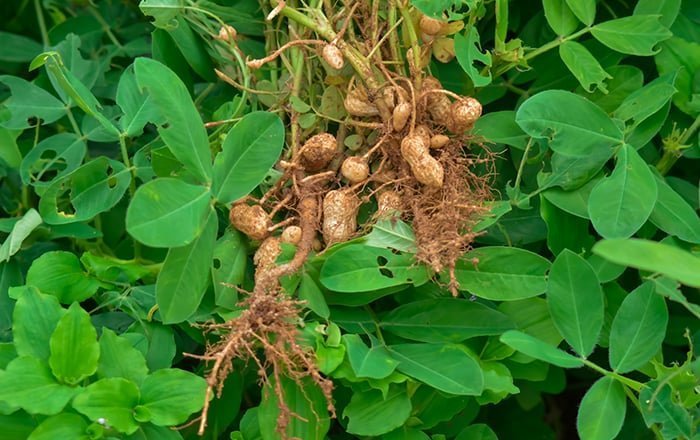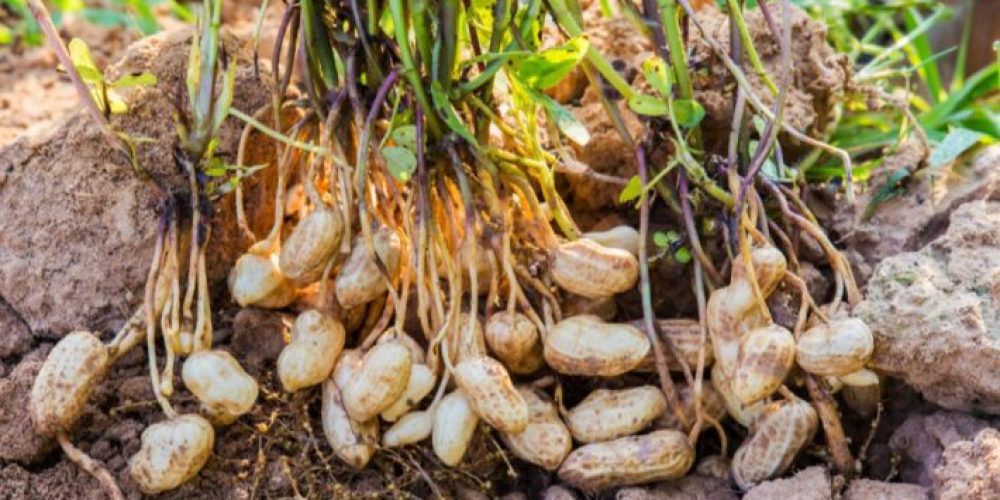Table of contents of the article
TogglePeanuts are an important and beloved food crop all over the world. In this article, we at the World of Plants website have explained what peanuts are, then we have explained how to grow them and take care of them.
What is peanut?
Peanuts are a type of oil crop that grows on the peanut plant. Peanuts are considered a rich source of protein, fiber, healthy fats, vitamins, and minerals. They also have many health benefits, such as promoting heart health, strengthening the immune system, and improving skin and hair health. Peanuts can be eaten as a snack, added to salads and meals, or used peanut butter in cooking.
How to grow peanuts
Here's how to grow peanuts:
First: Choose the appropriate location
- It is best to choose a sunny location that provides good water drainage.
- The soil should have a good layer of loosened sand and clay soil.
Second: Preparing the soil
- Soil plowing: The soil should be plowed to a depth of about 10-15 cm and weeds and stones removed. Organic fertilizer can be added to improve soil quality.
- Planting seeds: Place the seeds in pre-plowed furrows about 5 cm deep and 10-15 cm apart from each other. Use high quality seeds.
- Irrigation: Suitable soil moisture must be ensured while plants are growing. It is recommended to water the plants regularly by spraying or placing a drip irrigation system near the plants.
Third: Taking care of plants
Weeds should be removed regularly around emerging plants and provided with good support as the plant grows older.
Fourth: Harvesting peanuts
About 90-110 days after planting, you can tell the peanuts are ready for harvest by watching their outer shell turn brown. You can cut the plant with the inside of the pods and hang them to dry the peanuts before harvesting them.
These are general procedures for growing peanuts, and it is recommended to research further, obtain information specific to your area and consult with local farmers for further advice and guidance.
How to grow peanuts at home
Growing peanuts at home is easy and can be done using the following steps:
First: Choosing the appropriate land
- You should choose a sunny location for planting peanuts.
- The soil is preferably nutrient-rich and well-drained.
Second: Preparing the soil
It is preferable to plow the soil well and remove weeds and gravel. Organic fertilizer such as permafrost or chicken manure can be added to improve soil fertility.
Third: Planting seeds
Peanut seeds are placed in the ground about 5 cm deep, with an interval of about 10-15 cm between each seed.
Fourth:- Irrigation
After planting the seeds, the soil must be irrigated well so that it is moist. Then the volume of irrigation can be reduced after the seedlings appear.
Fifth:- Daily care
Weeds around emerging plants should be removed and excess leaves trimmed to stimulate plant growth.
Sixth: Fertilization
A balanced fertilizer can be applied during the growing period to enhance plant productivity. It is advisable to consult on specific fertilization methods and according to local needs.
Seventh: Harvesting peanuts
Peanuts can be harvested after the plants grow and the pods mature. The pods should be collected and dried well before opening them for seed use.
Eighth: The date and lands suitable for agriculture
The best time to plant peanuts is mid-April to mid-May. As for agricultural lands, peanuts are best planted in yellow and sandy lands, but not in heavy clay lands or poorly drained lands.
Varieties, seed rate and treatment of peanuts
Among the varieties that are cultivated are Giza 4, 5, and 6. As for the seed rate, an acre needs 75 to 80 kg of pods, or about 40-50 kg of seeds. As for the methods of seed treatment, they are treated before planting as follows:
Fungicides are applied one day before planting and treated with one of the following compounds:
- Thiram at a rate of 3g/kg seeds
- Thiophanate methyl at a rate of 3 g/kg seeds
- Hemexazole at a rate of 3g/kg of seeds
As for the treatment with the contract, it is done immediately before planting, which is bacteria bags that work to stabilize atmospheric nitrogen in the soil, and the seeds are treated with it before planting.
Preparing the land for planting peanuts

As for preparing the land, the land is plowed well with the following fertilizers added: organic fertilizer (20 cubic meters/acre) + super phosphate (200-300 kg/acre) + potassium sulfate (25 kg/acre). Then the land is planned into lines 80 cm wide on the back of the terrace. Irrigation hoses are spread over the lines, and it can also be planted with a sprinkler or pivot irrigation system.
Peanut cultivation process
As for the agricultural process, the seeds are planted on both sides of the terrace, at a distance of 10 cm between the holes. Irrigation is also done immediately after the completion of the planting process so that the two nodes added to the seeds are not affected.
Irrigation and fertilization operations for peanuts
- Irrigation is carried out almost daily, or one and a day, or one and two days, depending on the nature of the soil and the prevailing weather conditions in each region
- As for fertilization, nitrogen fertilization is done in the event of successful bacterial inoculation (two decades). Here, a rate of 50 kilograms of urea fertilizer or ammonium nitrate is added. If bacterial inoculation is not successful, ammonium nitrate fertilizer is added at a rate of 100 kilograms/acre, divided into stages until the beginning of flowering.
- In phosphate fertilization: Phosphoric acid fertilizer is added at a rate of 30 kg/acre and added with irrigation water and divided into batches from after germination until the flowering and contracting stage.
- In potassium fertilization, add at a rate of (50 kg/acre potassium sulfate fertilizer).
- Calcium fertilizer is also added at a rate of 25 kg/acre, calcium nitrate fertilizer during the flowering process.
- Spraying with micronutrients (iron, zinc, manganese, and boron) at a rate of 500 g/acre, twice a season.
Weed control, ripening and harvesting
In the case of combating broad-leaved weeds, spraying is done with a compound (pentazone), and to combat narrow-leaved weeds, spraying is done with a compound (clethodum - or haloxyfop p-methyl - or fluzifop p-butyl).
As for maturity, its signs include yellowing of the leaves and the ease of opening of the pods when pressed, then the inner seed shells are colored red, and the harvest occurs after approximately 120 days of age, pointing out that by following the correct cultivation methods, the production rate reaches from 1,500 to 2,000 kg per acre.
In conclusion, we would like to note that we, at the world of plants website, offer you all the necessary services in the world of plants, we provide all farmers and those interested in plants with three main services::-
- Artificial intelligence consulting service to help you identify diseases that affect plants and how to deal with them.
- Blog about plants, plant diseases and care of various crops ... You are currently browsing one of her articles right now.
- An application that provides agricultural consultations to clients, as well as a service for imaging diseases and knowing their treatment for free – Click to download the Android version from Google Play Store، Click to download the IOS version from the Apple App Store.




